

Vol. 41 (Issue 07) Year 2020. Page 21
ISTOMINA, Anna I. 1; VINOGRADOVA, Marina V. 2; LUKYANOVA, Anna V. 3; DOBROVOLSKAYA, Oksana P. 4 & PRODANOVA, Natalia A. 5
Received: 12/11/2019 • Approved: 11/02/2020 • Published 05/03/2020
ABSTRACT: According to experts, 70% of the values created in the economy over the next decade will be based on digital platforms. Digital economy is based on digital developments and software, as well as applications and telecommunications in any economic realm. The purpose of our research is to analyze the competitive strength of economies in the era of digital transformations. The study was based on the World Economic Forum reports. The analysis confirmed that the competiveness strategy of countries and regions should be developed based on the leading role of economy digitalization in all its aspects. |
RESUMEN: Según los expertos, el 70% de los valores creados en la economía durante la próxima década se basarán en plataformas digitales. La economía digital se basa en desarrollos digitales y software, así como en aplicaciones y telecomunicaciones en cualquier ámbito económico. El propósito de nuestra investigación es analizar la fortaleza competitiva de las economías en la era de las transformaciones digitales. El estudio se basó en los informes del Foro Económico Mundial. El análisis confirmó que la estrategia de competitividad de los países y regiones debería desarrollarse en función del papel principal de la digitalización de la economía en todos sus aspectos. |
Digital economy is based on information and communication technologies. It consists of four sectors: telecommunications, information technology, consumer electronics and digital content. According to the world statistics, investments in information and communication technologies foster productivity, employment and GDP. Digitalization of the economy is considered as the main reason for innovation, economic growth and social transformations (Olbert & Spengel, 2017). The main distinguishing features of digital economy are as follows: geographical location is no longer a competitive advantage; trading platforms and the development level of communication networks, as well as the use of big data in business play the main role (Valenduc & Vendramin, 2016). On the other hand, traditional industrial structures and business models are being destroyed due to innovative products and services, cost structure changes, lower entry barriers and cost variation. Companies should rethink the ways to create, share and capture value in the new digital environment.
Competitiveness is the ability of the country to redistribute the value created in the global economy in its favor. This is ensured through providing conditions for creating greater value added to maintain a high living standard in the country. The Fourth industrial revolution (Industry 4.0) quickly leads to significant changes in all sectors of the economy, both at the national and macroeconomic levels. According to the World Economic Forum (Shaping the Future of Digital Economy and New Value Creation, 2019), more than 60% of global GDP is expected to be digitized by 2022. According to experts, 70% of the new values created in the economy over the next decade will be based on digital platforms. Currently, about a half of the world's population is not involved in the digital economy, which slows down the Internet growth. According to (Shaping the Future of Digital Economy and New Value Creation, 2019), a 10% increase in the country's digitalization indicator results in a 0.75% increase in GDP per capita, as well as a significantly reduced unemployment rate.
Digital economy is an economy based on digital development and software, as well as applications and telecommunications in any economic realm, covering internal and external activities of organizations (Domazet & Lazić, 2017). At the same time, this is a knowledge-based economy due to the fact that it is based on professional and market knowledge, creativity and innovative potential of the society. Digital economy is the paradigm of the information society based on the use of technological platforms, mobile or electronic devices and the development of a set of financial and economic tools in the system of production, distribution, exchange and consumption of goods and services in global markets (Tsyganov & Apalkova, 2016).
Currently, effective digital economy infrastructure is the main condition for increasing the international competitiveness of middle-income countries that want to bridge the development gap and avoid the problem of middle-income traps. The authors of (Balcerzak & Bernard, 2017) believe that from a national perspective, investing in digital economy can be a tool that supports sustainable development and increases competitiveness at the regional and global levels. In this regard, comparative studies on the digital economy development should be considered as an urgent and important scientific task.
The rapid introduction of information and communication technologies has significantly influenced the perception of the efficiency and effectiveness of economic models. In the economic literature and official strategic documents, the information on digital economy is often referred to as the most desirable strategy for further national and global development (Tsyganov & Apalkova, 2016). The authors of the article (Tsyganov & Apalkova, 2016) presented the classification of concepts related to the digital economy and divided them into four main groups: macroeconomic, structural, management and technological approaches. The analysis shows that the rapid development of electronic commerce in Europe laid the foundation to the growth in other economy sectors, including express delivery markets and electronic payment services (Gazzola et al., 2017; OECD, 2017; Pagoropoulos at el., 2017; Sutherland & Jarrahi, 2018). It was also proved that the developed financial infrastructure of the country fosters the development of the information society and digital economy.
Many authors (El Bilali & Allahyari, 2018; Rotz et al., 2019) argue that digitalization contributes to the integration of product creation, management, value added and marketing. Digitalization plays a key role in expanding the market. Information and communication technologies (ICTs) connect manufacturers with customers to build and maintain long-term, mutually beneficial and sustainable professional relationships. Modern economy is developing in the technological dimension, gradually becoming a virtual economic system. Digital economy is a new approach to economic development, where business relations are based on the use of information (Vovchenko et al., 2017).
In recent years, technological breakthroughs have brought new forms of mediation, service and consumption. Following decreased productivity, this prompted debates about the conceptual basis of GDP and the adequacy of the existing assessment methods (Ahmad & Schreyer, 2016). The authors of (Ahmad & Schreyer, 2016) concluded that the GDP accounting framework corresponds to the challenges associated with digitalization. In (Van Ark, 2016), it is noted that despite the rapidly increased selling expenses on capital and ICT services, the new digital economy (mobile technology, the Internet and cloud technology) has not significantly fostered productivity growth; the new economy is still in its "pioneering stage" and the result will become visible only after the technology enters the "deployment stage".
Thus, the analysis of publications revealed that there is a great interest in the issues of digital transformation and related economic changes. New conditions, along with the development of ICTs and globalization of markets, bring up new opportunities for the development of economies. The purpose of our research is to analyze the competitive strength of economies in the era of digital transformations and assess the concept of digitalization from the perspective of national competitiveness.
The competitiveness of the country depends on the competitiveness of national companies in both domestic and foreign markets. In the digital era, the country's competitiveness is determined by long-term factors: the application of innovation and global integration.
The 2018 edition of the Global Competitiveness Report (2018) introduces the new Global Competitiveness Index 4.0. The Global Competitiveness Index (GCI) 4.0 assesses the factors determining the competitiveness of the country, which is the most important factor contributing to the long-term improvement of living standards (The Global Competitiveness Report, 2018). The new index sheds light on productivity drivers and long-term growth in the era of the Fourth industrial revolution. In (The Global Competitiveness Report, 2018), there is a report on the Global Competitiveness Index 4.0, which assesses the competitiveness of 140 countries and provides unique information on the drivers of economic growth.
Thus, the data presented in (The Global Competitiveness Report, 2018) provide the most complete analysis of various factors determining the competitiveness of the economy, as well as the assessment of the ICTs role and the level of digitalization in the context of global competitiveness.
The Global Competitiveness Index analyzes performance of countries on 12 pillars: institutions, infrastructure, macroeconomic environment, health and primary education, higher education and training, goods market efficiency, labor market efficiency, financial market development, technological readiness, market size, business sophistication and innovation. The pillars are grouped into three categories (subindices) in accordance with the three main stages of development: basic requirements, efficiency enhancers and factors of innovation and sophistication. The subindices are assigned different weights when calculating the total index. They depend on the stage of development of each economy which is expressed in terms of GDP per capita and the share of mineral exports.
The Fourth industrial revolution is associated with new fundamental changes in national economies. These concepts span across the factors covered by the Global Competitiveness Index. The factors are organized into 12 pillars which are grouped into four categories (Enabling Environment, Human Capital, Markets and the Innovation Ecosystem). Based on the analysis of publications and expert opinions, the authors of (The Global Competitiveness Report, 2018) discuss all important productivity factors in the era of the Fourth industrial revolution.
Let us consider in more detail the indicators organized into 12 pillars.
Pillar 1: Institutions. It considers security, property rights, social capital, a system of checks and balances, transparency and ethics, public sector performance and corporate governance. By setting legal and informal restrictions, institutions determine the context in which individuals organize themselves and their economic activities. Institutions influence productivity, mainly by providing incentives and reducing uncertainties.
Pillar 2: Infrastructure. It captures the quality and expansion of transport infrastructure and utility infrastructure. Well-connected geographic areas were generally more prosperous. A well-developed infrastructure reduces transportation and transaction costs; it also facilitates the movement of goods and people and the transfer of information within and outside the country. It also provides access to the conditions necessary for modern economic activity: electricity and water.
Pillar 3: ICT adoption. The degree of dissemination of specific information and communication technologies. ICTs reduce transaction costs and accelerate the exchange of information and ideas, increase efficiency and promote innovation. Since ICTs are general purpose technologies increasingly introduced into the structure of the economy, they become as important as power and transport infrastructure.
Pillar 4: Macroeconomic stability. Inflation rate and fiscal policy sustainability. Moderate and predictable inflation and sustainable government budgets reduce uncertainties, set investment return expectations and increase business confidence, which increases productivity. In addition, in an increasingly interconnected world where capital can move quickly, a loss of confidence in macroeconomic stability can trigger capital outflows with destabilizing economic consequences.
Pillar 5: Health. Health-adjusted life expectancy is the average number of years that a person is expected to live. Healthier people have more physical and mental abilities; they are more productive, creative and tend to invest more in education as their life expectancy increases. Healthy children develop into adults with stronger cognitive abilities.
Pillar 6: Skills. The general qualification of the workforce, as well as the quantity and quality of education. Although the education quality concept is constantly being developed, important quality factors include: the development of digital literacy, interpersonal communication skills, critical and creative thinking. Education builds skills and competencies in the workforce. Highly educated groups of the population are more productive because they have a greater collective ability to perform tasks, quickly transfer knowledge, as well as create new knowledge and applications.
Pillar 7: Product Market. The pillar captures the extent to which a country provides a level playing field for the companies to participate in its markets. It is measured in terms of the degree of market power, openness to foreign firms and the degree of market distortion. Competition improves productivity by encouraging companies to innovate; update products, services and organization; as well as to supply the best products at fair prices.
Pillar 8: The labor market. It includes “flexibility,” namely, the extent to which human resources can be reorganized, and “talent management,” namely, the extent to which human resources are used. Well-functioning labor markets contribute to productivity by matching workers with the most suitable jobs for their skills and developing talent to reach their full potential. By combining flexibility with the protection of fundamental human rights, well-functioning labor markets enable countries to be more resilient to shocks and redistribute production into new segments; encourage workers to take risks; attract and retain talents, as well as motivate workers.
Pillar 9: The financial system. It includes the availability of credit, capital, debt, insurance, and other financial products, as well as stability, namely, the mitigation of excessive risk and opportunistic behavior of the financial system. A developed financial sector contributes to productivity in three ways: pooling savings into productive investments; improving the allocation of capital for the most promising investments by monitoring borrowers, reducing the information asymmetry and providing an efficient payment system. At the same time, there is a need for proper regulation of financial institutions in order to avoid financial crises that can cause long-term negative effects on investment and productivity.
Pillar 10: Market Size. The pillar describes the size of the domestic and foreign markets that can be accessed by national companies. Large markets increase productivity due to their scale: the unit cost tends to decrease depending on the output. Large markets promote innovation. Ideas are non-rival: the more potential users there are, the greater potential return on a new idea will be. Moreover, large markets create positive externalities as human capital accumulation and knowledge transfer increase the return on the scale of the new technology or knowledge.
Pillar 11: Business dynamism. The ability of the private sector to generate and implement new technologies and new ways of organizing work through a culture that includes changes, risks, new business models and administrative rules that allow firms to easily enter and exit the market. A flexible and dynamic private sector increases productivity by assuming business risks, testing new ideas and creating innovative products and services. Under the conditions characterized by frequent violations and redefinition of enterprises and sectors, successful economic systems are resistant to technological shocks and are able to constantly redevelop.
Pillar 12: Innovation. It captures the quantity and quality of formal research and development; the degree to which the situation in the country encourages cooperation, interaction, creativity, diversity and confrontation from different perspectives; and the ability to turn ideas into new products and services. As a rule, countries that can accumulate more knowledge and offer better collaborative or interdisciplinary opportunities have more opportunities to generate innovative ideas and new business models that are widely regarded as drivers of economic growth.
The study was based on the World Economic Forum data. Eleven groups of countries located in different regions (Europe, Asia, the Middle East, etc.) and having different per capita income were selected. The indicators of the 12 pillars were assessed and the hypothesis of the key influence of digitalization on competitiveness was analyzed. The indices are presented on a 100-point scale.
Let us consider the data calculated for various groups of countries (Fig. 1). The analysis shows that the countries of Europe and North America are traditionally far ahead; the value of the Competitiveness Index also correlates with the level of income.
Figure 1
Global Competitiveness
Index 4.0
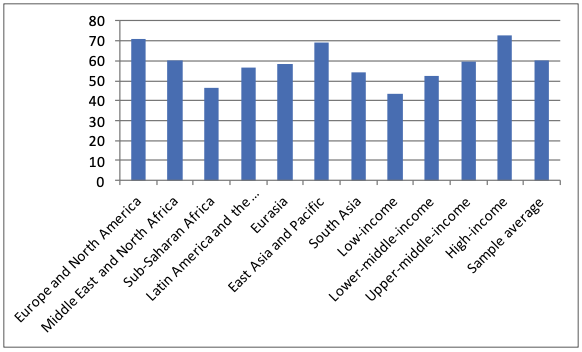
(according to the data from (The Global Competitiveness Report, 2018))
Figure 2 shows the Global Competitiveness Index rankings based on the income level. It should be noted that the largest gap is observed in the adoption of ICT. In addition, this figure is not high enough even for developed countries.
Figure 2
Global Competitiveness
Index 4.0, by pillars
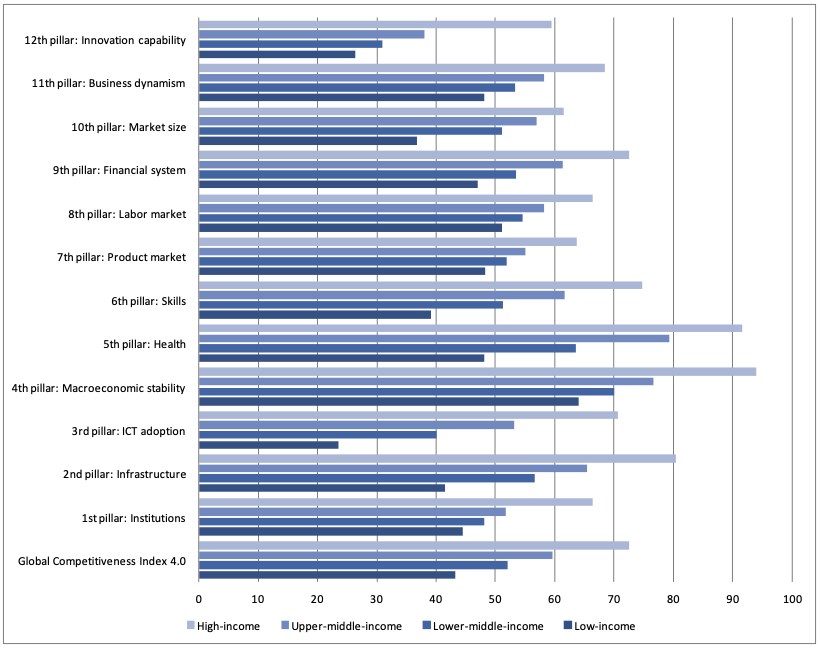
(according to the data from (The Global Competitiveness Report, 2018))
Let us consider the relationship between the Competitiveness Index and the geographical region (Fig. 3-9). The analysis of the histograms showed that the ICT adoption index is very low for the countries producing raw materials.
Figure 3
Differentiation of the Competitiveness Index and
its components in Europe and North America
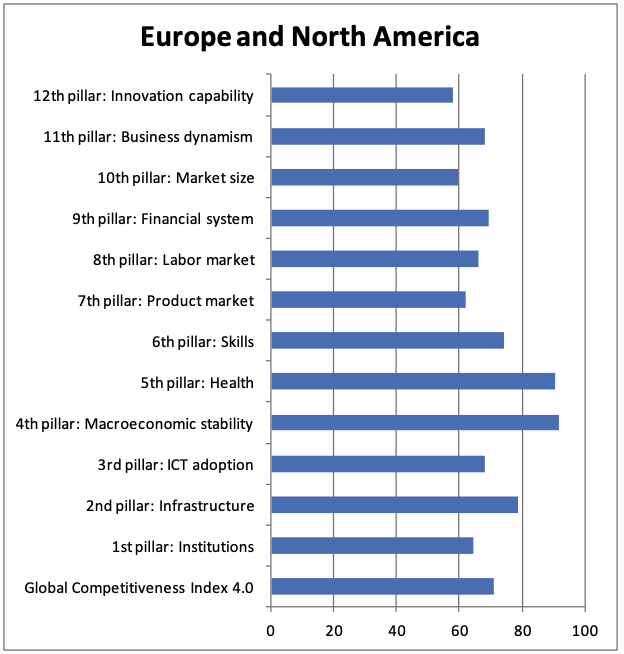
(according to the data from (The Global Competitiveness Report, 2018))
Figure 4
Differentiation of the Competitiveness Index and its
components in the Middle East and North Africa
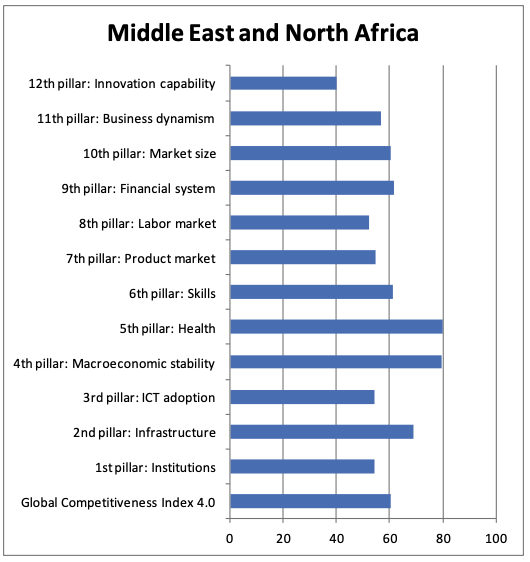
(according to the data from (The Global Competitiveness Report, 2018))
Figure 5
Differentiation of the Competitiveness
Index and its components in Eurasia
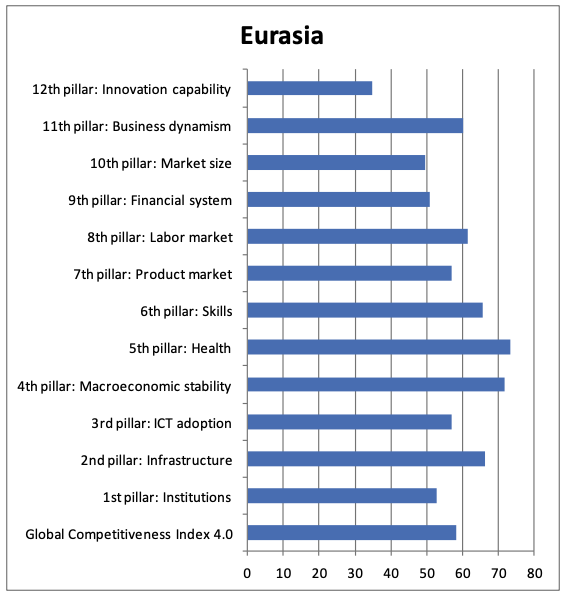
(according to the data from (The Global Competitiveness Report, 2018))
Figure 6
Differentiation of the Competitiveness Index and its components in Sub-Saharan Africa
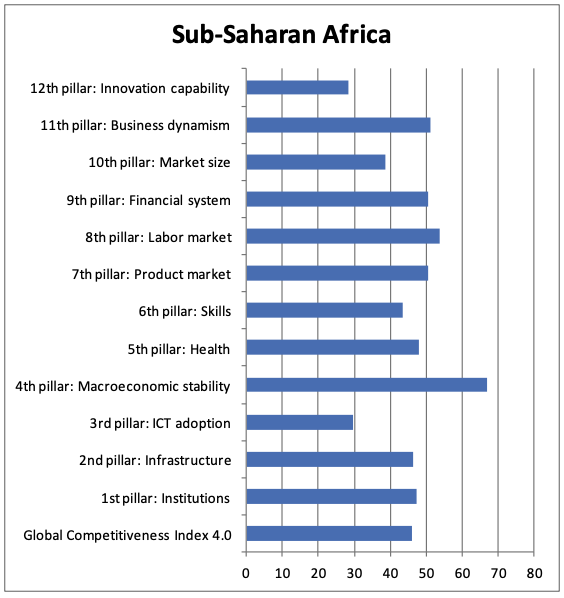
(according to the data from (The Global Competitiveness Report, 2018))
Figure 7
Differentiation of the Competitiveness Index and its
components in Latin America and the Caribbean
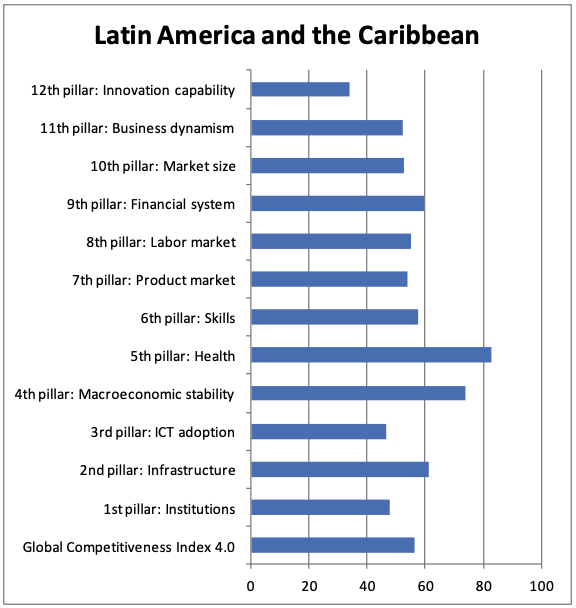
(according to the data from (The Global Competitiveness Report, 2018))
Figure 8
Differentiation of the Competitiveness
Index and its components in South Asia
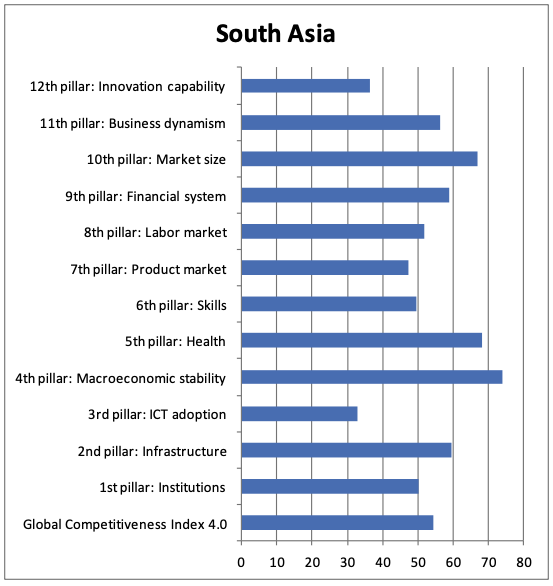
(according to the data from (The Global Competitiveness Report, 2018))
Figure 9
Differentiation of the Competitiveness Index
and its components in East Asia and the Pacific
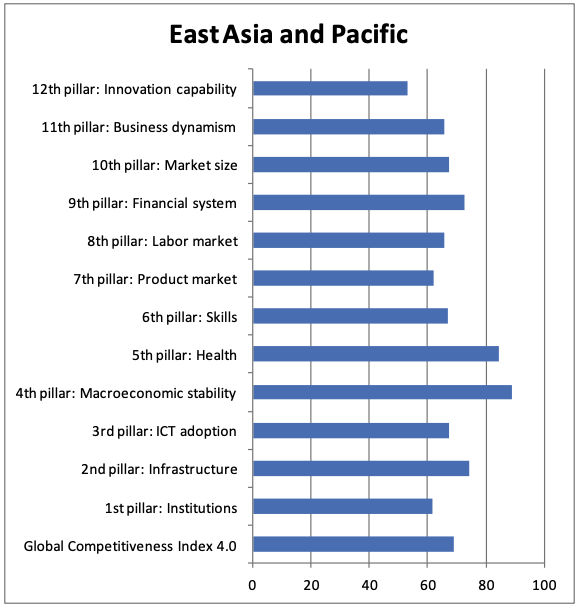
(according to the data from (The Global Competitiveness Report, 2018))
It is known that financial crises can have long-term effects on productivity. Prolonged periods of underinvestment caused by the financial crisis can reduce the long-term growth trajectory, which will make the economic system less prosperous even after the recovery of the financial sector. At the same time, digitalization of life and the industrial revolution 4.0 accelerate the innovation cycle and make business models obsolete. This process of constant creative destruction creates opportunities for new entrants and reduces the barriers to technology or innovation transfer. To respond to these challenges, a successful economy should create appropriate mechanisms to reduce the risk of new financial crises and to manage the socio-economic effect of innovation.
Digital transformation is one of the mechanisms that can bring the national economy to a qualitatively new level. Let us consider the assessment of the ICT adoption index in more detail (Fig. 10, 11).
Figure 10
ICT adoption index by regions
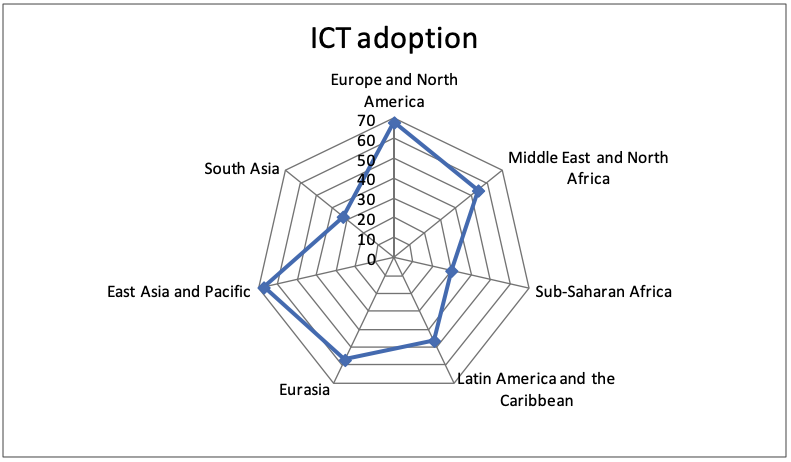
(according to the data from (The Global Competitiveness Report, 2018))
Figure 11
ICT adoption index by income
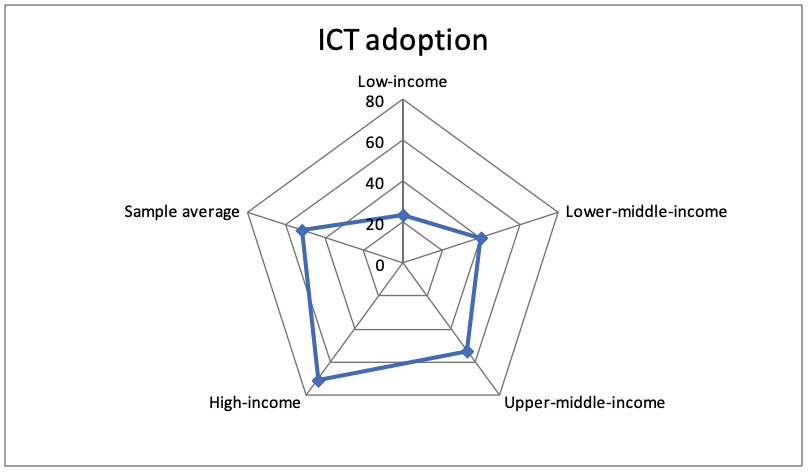
(according to the data from (The Global Competitiveness Report, 2018))
The analysis shows that the indicator is quite high in both traditionally developed countries and rapidly growing economies (Fig. 10). The value of the ICT adoption index in these regions is about 70 points on a 100-point scale. At the same time, the values of this index correspond to the economic development level (Fig. 11). High-income countries have higher rates than lower-income countries.
Based on the analysis of the World Economic Forum report (The Global Competitiveness Report, 2018), the following conclusions can be drawn. The United States is the closest country to the frontier mark of competitiveness (85.6 points). At the same time, the ICT introduction is relatively low compared to other developed economies, including such aspects as subscription to mobile broadband networks and the number of Internet users. In addition to the United States, the top ten countries also include Germany (82.8), Japan (82.4) and the United Kingdom (82.0). The results are very diverse for different countries and economies. Almost 30 points separate the United States from Argentina (57.5), which is the worst economy in terms of competitiveness.
The USA is followed by Singapore (83.5 points). The country also has a leading position in terms of infrastructure with an almost perfect score of 95.7 points. In addition to Singapore and Japan, Hong Kong is the third largest economy from East Asia and the Pacific in the top ten, confirming the widespread belief that the general growth impact in the region has been preserved. These three countries possess world-class physical and digital infrastructure and connectivity. Emerging markets, such as Mongolia (52.7) and Cambodia (50.2), are halfway to the frontier. This makes them vulnerable to sudden shocks, such as faster increase in interest rates and escalation in trade tension.
When it comes to competitiveness, Europe consists of four groups: a very competitive northwest, a relatively competitive southwest, a growing northeast region and a lagging southeast. The competitiveness of Latin America and the Caribbean remains unstable and can be jeopardized by a number of factors. Insecurity and weak institutions are the two biggest problems for most countries. The competitiveness in the Middle East and North Africa is different: Israel (76.6) and the United Arab Emirates (73.4) are at the top of the list. The emphasis on intra-regional connectivity combined with improved ICT readiness and investment in human capital will improve the region's ability to innovate, stimulate business dynamism and increase its competitiveness. Seventeen out of the 34 countries in Sub-Saharan Africa are among the bottom 20 countries.
Thus, the Global Competitiveness Index 4.0 is a new indicator that assesses the factors that collectively determine the level of economic performance. The GCI 4.0 platform is built on 12 key performance factors. They include 98 individual indicators. The results of the study prove the adequacy of the presented methodology. The descriptive capabilities of the Index and its components make it possible to carry out a complete and comprehensive analysis of competitiveness at both the national and regional levels.
Many authors (Valenduc & Vendramin, 2016; Domazet & Lazić, 2017; OECD, 2017; Pagoropoulos et al., 2017) note that the introduction and development of modern ICT solutions play a key role in the development of digital economy. Significant investments in ICT and the development of the IT sector can contribute to creating a strong economy based on knowledge and information technology. Digital technologies that have been recently introduced, such as the Internet of Things (IoT) and Big Data have great potential and can be used to develop a system of products and services in all economic realms (Pagoropoulos et al., 2017). Digital economy has allowed the use of blockchain for financial transactions. This ensures high quality and reliability in the implementation of contracts (Olbert & Spengel, 2017).
The European Union is dealing with fundamental questions related to its future direction. The key issue is the role of European integration in improving the competitiveness and prosperity of Europe (Ketels & Porter, 2018). The new model for enhancing the competitiveness of Europe is determined by the opportunities brought by digitalization, which is an important component of the competitiveness strategy in the modern world.
Today investments in digital infrastructure and the creation of an effective digital economy are considered as the main conditions for maintaining and developing international competitiveness. The development of a digital economy can support the process of convergence and bridging the development gap between regions. In this context, the results of the comparative analysis confirm the hypothesis about the key role of digitalization of the economy in the modern world. Digital economy is usually regarded as a complex phenomenon.
The research was based on the World Economic Forum data. National competitiveness is defined as the ability of a country and its institutions to ensure economic growth that would be sustainable in the mid-term perspective. According to the analysis, countries with high levels of national competitiveness usually have a higher living standard. The analysis confirmed that the competitiveness strategy of countries and regions should be based on the leading role of digitalization.
Ahmad, N., & Schreyer, P. (2016). Are GDP and productivity measures up to the challenges of the digital economy? International Productivity Monitor, 30, 4.-27
Balcerzak, P., & Bernard, M. P. (2017). Digital economy in Visegrad Countries. Multiple-criteria decision analysis at regional level in the years 2012 and 2015. Journal of Competitiveness, 9(2), 5 – 18.
Domazet, I., & Lazić, M. (2017). Information and communication technologies as a driver of the digital economy. In: XXII International Scientific Conference Strategic Management and Decision Support Systems in Strategic Management: proceedings. Ekonomski fakultet, Subotica, pp. 11-19.
El Bilali, H., & Allahyari, M. S. (2018). Transition towards sustainability in agriculture and food systems: Role of information and communication technologies. Information Processing in Agriculture, 5(4), 456-464.
Gazzola, P., Colombo, G., Pezzetti, R., & Nicolescu, L. (2017). Consumer empowerment in the digital economy: Availing sustainable purchasing decisions. Sustainability, 9(5), 693.
Ketels, C. H., & Porter, M. E. (2018). Towards a New Approach for Upgrading Europe's Competitiveness. Harvard Business School.
OECD (2017). OECD Digital Economy Outlook 2017, OECD Publishing, Paris. Retrieved from http://dx.doi.org/10.1787/9789264276284-en
Olbert, M., & Spengel, C. (2017). International taxation in the digital economy: challenge accepted. World tax journal, 9(1), 3-46.
Pagoropoulos, A., Pigosso, D. C., & McAloone, T. C. (2017). The emergent role of digital technologies in the Circular Economy: A review. Procedia CIRP, 64, 19-24.
Rotz, S., Gravely, E., Mosby, I., Duncan, E., Finnis, E., Horgan, M., ... & Pant, L. (2019). Automated pastures and the digital divide: How agricultural technologies are shaping labour and rural communities. Journal of Rural Studies, 68, 112-122.
Shaping the Future of Digital Economy and New Value Creation (2019). Retrieved from https://www.weforum.org/platforms/shaping-the-future-of-digital-economy-and-new-value-creation
Sutherland, W., & Jarrahi, M. H. (2018). The sharing economy and digital platforms: A review and research agenda. International Journal of Information Management, 43, 328-341.
The Global Competitiveness Report (2018). Retrieved from http://reports.weforum.org/global-competitiveness-report-2018/
Tsyganov, S., & Apalkova, V. (2016). Digital Economy: a new paradigm of global information society. Economic Review, 45.
Valenduc, G., & Vendramin, P. (2016). Work in the digital economy: sorting the old from the new. Working papers - European Trade-Union Institute (ETUI), 03, 52
Van Ark, B. (2016). The productivity paradox of the new digital economy. International Productivity Monitor, 31, 3.
Vovchenko, N. G., Andreeva, A. V., Orobinskiy, A. S., & Filippov, Y. M. (2017). Competitive advantages of financial transactions on the basis of the blockchain technology in digital economy. European Research Studies, 20(3B), 193.
1. Department of restaurant business, Plekhanov Russian University of economics, Moscow, Russian Federation; istominaanna95@bk.ru
2. The Institute of perspective directions and technologies, Russian State Social University, Moscow, Russian Federation
3. Department of Management, Financial University under the Govemment of the Russian Federаtiоn, Moscow, Russian Federation
4. Department of state and municipal administration, V.I. Vernadsky Crimean Federal University, Simferopol, Russian Federation
5. Department of Financial Control, Analysis and Audit, Basic chair of the Main control Department of Moscow, Plekhanov Russian University of Economics, Moscow, Russian Federation
[Index]
revistaespacios.com

This work is under a Creative Commons Attribution-
NonCommercial 4.0 International License